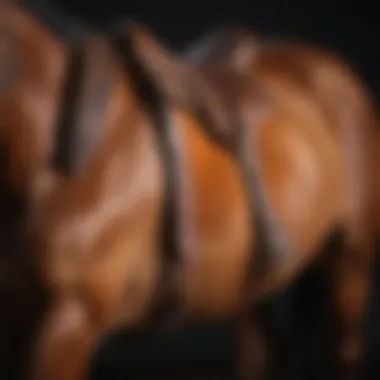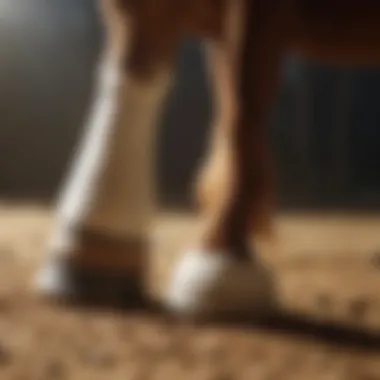Top Half Pads for High-Withered Horses


Intro
The horse riding community faces several challenges when it comes to catering to horses with unique characteristics. High-withered horses, known for their pronounced muscle structure along the shoulders, may struggle with discomfort while being saddled. This issue not only impacts their well-being but can also affect their performance during rides. Therefore, selecting the right half pad becomes crucial for both comfort and efficacy.
In this article, we will delve into optimal choices for half pads specifically designed for high-withered horses. We'll explore their features, the importance of material, pad thickness, and fitting. Understanding these components is vital for horse owners who wish to enhance riding experiences. Additionally, we will present insights tailored to equine enthusiasts, empowering riders with knowledge that can significantly impact their horses’ comfort and performance.
Understanding High-Withered Horses
Understanding the unique characteristics and requirements of high-withered horses is essential for any horse owner or equestrian. High withers refer to the area where the horse's back begins to rise significantly, creating a prominent ridge just above the shoulder blades. This anatomical feature is more common in certain breeds and can affect both comfort and performance during riding.
Defining High Withers
High withers are defined by a notable upward slope from the back to the neck, leading to a pronounced peak at the withers. This shape can limit the natural fit of saddles and pads, which propmt a need for specialized equipment. Recognizing high withers starts with observing the horse's profile. Owners should measure from the saddle area to the ground to understand better how the horse's build comes into play.
Common Challenges Faced
Horses with high withers often experience several challenges. Common issues include:
- Saddle Fit Problems: Traditional saddles may not conform well, causing discomfort or inadequate weight distribution.
- Pressure Points: Improper fitting can lead to pressure on the withers, resulting in pain or reluctance to work.
- Reduced Performance: Discomfort caused by ill-fitting equipment can impair the horse’s movement and overall performance.
"Understanding the physical structure of high-withered horses is key to selecting the proper gear, impacting both their comfort and performance."
In summary, a deep understanding of what high withers entail enables horse owners to choose the right equipment. Selecting appropriate half pads becomes crucial to cater to the unique needs of these horses. Being informed not only enhances riding experience but also contributes to the horse’s overall well-being.
Importance of Proper Padding
Proper padding is crucial for the well-being and comfort of high-withered horses. This aspect significantly affects how riders connect with their equine partners and can eliminate many physical challenges faced by horses. Choosing the right half pad ultimately enhances not just the horse's experience, but also the performance and bond between horse and rider.
First, it is essential to observe how different withers affect saddle fit. Horses with prominent withers often struggle with saddle placement. An ill-fitted saddle can lead to discomfort, pain, and potential long-term damage. Half pads serve to provide an additional layer of cushioning between the saddle and the horse’s back. This extra cushion helps to better distribute the rider's weight and can reduce pressure points that typically impact high-withered horses.
When evaluating half pads, consider the following points:
- Customization: Half pads adapt to the shape of the horse’s back. Using a pad designed specifically for high withers ensures more effective support.
- Shock Absorption: Proper padding absorbs shocks that occur during riding. This significantly reduces the risk of back injuries or muscle strain in high-withered horses.
- Comfort: Well-padded halves can make a difference in the comfort level of the horse, greatly influencing its willingness to perform.
"The right half pad can eliminate discomfort and promote better performance for high-withered horses."
Benefits of Half Pads
Half pads offer various benefits that are particularly advantageous for high-withered horses. With the right choice, owners can address several issues:
- Enhanced Fit: Half pads provide a customizable fit to fill the gaps caused by the conformation of high-withered horses.
- Increased Stability: A well-fitted half pad prevents saddle slippage, improving the rider's stability and control.
- Pressure Relief: These pads reduce localized pressure on the horse’s spine and withers, which can result in discomfort or injury.
- Temperature Regulation: Certain materials assist in regulating heat and moisture, keeping your horse cooler during work.
Selecting high-quality half pads ultimately fosters better relationships between horse and rider.
Impact on Performance
The impact of proper padding on performance cannot be overstated. A high-withered horse equipped with suitable half pads experiences several performance advantages that can transform its ability.
- Freedom of Movement: With reduced constraint and pressure on the back, horses can move more fluidly. This can enhance their agility and responsiveness, crucial traits for various disciplines.
- Endurance: Comfort extends the horse's stamina during longer rides or intense training sessions, allowing them to give their best.
- Mental Focus: A comfortable horse is often a more focused one. The absence of pain or discomfort lets the horse concentrate on the task, be it jumping, dressage, or trails.
- Reduced Risk of Injury: Well-padded half pads can protect against injuries that stem from excessive physical stress. This not only preserves the horse's health but also prolongs its performance career.
Overall, investing in a proper half pad significantly influences both the comfort and performance of high-withered horses. The right padding effectively supports the animal, allowing for maximum functionality and enjoyment.


Types of Half Pads Available
Understanding the range of half pads available is crucial for horse owners, particularly for those dealing with high-withered horses. This type of horse typically has an anatomy that creates unique challenges. Thus, selecting the right half pad can significantly enhance both comfort and performance. By gaining insights into the various types of pads, one can make informed decisions that will ultimately benefit both the horse and rider.
Gel Half Pads
Gel half pads are popular due to their ability to absorb shock effectively. They distribute weight evenly across the horse’s back, reducing pressure points. These pads often provide a soft feel, which is essential for horses with sensitive skin.
The gel material also conforms to the horse's body shape, offering personalized comfort. Additionally, gel half pads can be easily cleaned, which is a practical advantage for regular use in muddy or wet conditions.
Main benefits include:
- Excellent shock absorption
- Easy maintenance
- Effective at maintaining saddle stability
Wool Half Pads
Wool half pads are made from natural fibers, making them suitable for moisture-wicking and temperature regulation. This is crucial for high-withered horses, which may suffer from overheating. The lanolin in wool also offers some antibacterial properties, which can help reduce skin irritations.
Wool half pads usually provide a thicker cushioning layer, offering a plush feel for the horse. However, care must be taken in terms of cleaning, as wool requires more attention to maintain its integrity and softness.
Key aspects include:
- Natural insulation and breathability
- Good cushioning without excessive bulk
- Antimicrobial properties
Memory Foam Half Pads
Memory foam half pads contour to the horse's body over time. This feature allows the pad to create a custom fit, which is especially beneficial for horses with unique body shapes. The pressure distribution capability of memory foam can greatly enhance comfort during rides.
These pads tend to be more expensive, but the long-term benefits often outweigh initial costs. Riders will find that memory foam can adapt to both the horse’s physique and the dynamics of riding, which can lead to improved performance.
Important considerations are:
- Custom fit improvements
- Enhanced comfort for prolonged use
- Often more expensive than other options
Neoprene Half Pads
Neoprene half pads are known for their durability and resilience. This material offers a level of waterproofing that can be beneficial in various weather conditions. Neoprene effectively absorbs shock and provides stable cushioning, which is paramount when riding high-withered horses.
While neoprene is typically lightweight, it can sometimes lead to overheating. Thus, owners should monitor how their horses react to prolonged use. Overall, neoprene half pads are suitable for regular training and can withstand rigorous riding conditions.
Considerations include:
- Offers durability and shock absorption
- Lightweight yet resilient
- Potential for overheating in certain conditions
Overall, the various types of half pads provide distinct benefits and features that cater to the needs of high-withered horses. Choosing the right kind not only contributes to the comfort of the horse but also optimizes performance in activities. Understanding these nuances can aid riders in making a well-informed selection.
Features to Consider in Half Pads
When selecting half pads for high-withered horses, it is essential to understand the specific features that contribute to comfort and performance. Not all half pads are created equal, and certain aspects can significantly enhance the riding experience. Each feature plays a crucial role in ensuring that the pad accommodates the horse’s conformation, provides adequate cushioning, and promotes proper posture.
Material Quality
The materials used in half pads are fundamental to their effectiveness. High-quality materials deliver durability and comfort. Common options include wool, gel, and neoprene.


- Wool offers natural breathability and moisture-wicking properties, which is beneficial for horses that sweat during rides.
- Gel provides excellent shock absorption, helping to reduce pressure points along the spine and withers.
- Neoprene, although sometimes criticized for limited breathability, can be highly effective in providing a snug fit and minimizing slippage.
Choosing the right material ensures the pad will serve its purpose while enhancing the horse's comfort during exertion.
Thickness and Density
The thickness and density of a half pad are critical factors in providing the right level of cushioning. A pad that is too thick may elevate the saddle, disrupting its fit, while one that is too thin cannot adequately support the horse’s frame.
- Thickness signifies how much cushioning the horse receives. Thicker pads may feel more comfortable but can also alter saddle fit.
- Density indicates how much protection will be provided. Denser materials also often last longer and better withstand the rigors of riding.
The ideal thickness and density will depend on the specific needs of the horse and the saddle being used. An effective half pad should aid in shock absorption while maintaining proper equipment positioning.
Shape and Design
Beyond fabric and stuffing, the shape and design of a half pad significantly affect performance and comfort. Several factors come into play here:
- Wither Cut: Pads designed for high-withered horses should feature a cut-out or contoured shape to prevent pressure on the withers, ensuring comfort.
- Saddle Slot: A well-designed slot aids in maintaining saddle stability while allowing for flexible movement.
- Side Panels: Enhanced side coverage can provide extra protection, especially if the horse has specific anatomical needs.
Ultimately, the shape and design should cater not only to the horse's unique body composition but also align with the rider's expectations during various disciplines.
Breathability and Moisture Control
The ability of a half pad to manage moisture and allow for air circulation is vital. High-withered horses often face overheating or excessive sweating; thus, effective moisture control can significantly affect their comfort.
- Breathable Materials help in reducing heat accumulation, which is critical during long rides or in warm weather.
- Moisture-Wicking Properties ensure that sweat does not build up against the horse’s skin, minimizing the risk of skin irritations and ensuring comfort through extended periods of wear.
Choosing a half pad that excels in breathability and moisture control will result in a more comfortable horse, allowing for better performance in various riding conditions.
"The right half pad can transform your riding experience and your horse’s comfort. Invest thoughtfully in each aspect to find the optimal solution."
In summary, understanding these features will equip equestrians with the knowledge needed to select a half pad that will suit their high-withered horses best. Assessing material quality, thickness, shape, and breathability are all steps toward ensuring that the horse remains comfortable and performs at its highest level.
Top Half Pads for High Withered Horses
Selecting the right half pad is crucial for horses with high withers. These pads not only help with comfort but they also impact overall performance. When a horse experiences discomfort due to improper fitting or inadequate cushioning, performance can suffer. Therefore, understanding the best options available can enhance the riding experience. This section will examine the leading half pads designed specifically for high-withered horses.
Review of Leading Brands
When discussing the top half pads for high-withered horses, several brands stand out in the market. These brands have shown high-quality manufacturing and innovation in their designs. The following is a brief overview of some noteworthy options:
- Mattes: Known for their high-quality wool and sheepskin products, Mattes pads provide excellent cushioning. Their half pads come with a unique design that accommodates high withers well.
- Thinline: This brand emphasizes shock absorption. Their products help distribute pressure evenly. Thinline pads are lightweight and provide a good fit for high-withered horses.
- Fleeceworks: Offering a range of materials, Fleeceworks pads focus on both comfort and durability. Their half pads are customizable to cater to specific needs.
- LeMieux: This brand offers high performance with stylish designs. LeMieux pads come in various colors and provide significant support for high withers.
Choosing a half pad from these brands ensures quality and effectiveness. Each brand has its strength, reflecting in the construction and materials used.
User Feedback and Ratings
Customer feedback plays a vital role in understanding how effective different half pads are. Reviews often highlight aspects such as comfort, durability, and ease of cleaning. Based on user feedback, here are insights regarding popular options:
- Mattes Pads: Users praise their comfort and cushioning. Many noted how well the pad conformed to their horse's back. A common rating is between 4.5 and 5 stars based on better fit and reduced soreness in high-withered areas.
- Thinline Pads: Customers appreciate the shock absorption properties. They commonly report improvement in their horse's performance during rides. Ratings often align in the 4 to 4.5 star range due to their lightweight nature.
- Fleeceworks Pads: These pads receive feedback for versatility. Many riders like their ability to be used in different disciplines. Ratings for Fleeceworks are often around 4 stars, focusing on comfort and fit.
- LeMieux Pads: Riders commonly express satisfaction with this brand for its combination of style and performance. Ratings often reach around 4.5 stars. Users frequently note a significant improvement in fit, especially for high withers.
Overall, user experiences provide critical insights into how these half pads perform in real-world settings. By examining ratings and feedback, potential buyers can make informed decisions. Understanding how each pad meets specific needs helps in selecting the ideal half pad for high-withered horses.
How to Fit Half Pads Properly


Fitting half pads correctly is essential for both the comfort and performance of high-withered horses. Proper fitting ensures that the pad supports the horse’s unique conformation while also promoting an even distribution of pressure under the saddle. Addressing the fitting process not only impacts the horse's well-being but also the rider's overall experience. When a half pad is well-fitted, it can help reduce friction, prevent soreness, and enhance the horse's movement.
Measuring Your Horse
The measurement phase is crucial. Riders must know their horse’s back length and wither height to select a half pad that is appropriate. To measure your horse:
- Stand on level ground: Ensure your horse is standing straight and square.
- Use a flexible measuring tape: Start at the point of the shoulder and measure to the point of the croup—this gives you the total back length.
- Measure the withers: From the top of the withers, measure down to the point where your saddle sits.
These measurements guide you towards a pad that fits well without causing too much bulk. It is also critical to consider the width between the withers and the spine. A pad that is too narrow can create pressure points, while a too-wide pad may slip.
Adjusting for Comfort
After selecting a half pad based on preliminary measurements, fine-tuning the fit is essential for optimal comfort. Here are some steps to follow:
- Check for slip: It should stay in place during movement.
- Saddle fit: Ensure that the saddle sits evenly on the horse’s back. Test by placing the saddle on without fastening the girth and check if there is any pinch at the withers or areas of discomfort.
- Padding Layer: If needed, add or remove padding. Some half pads allow adjustments to thickness or have removable inserts, giving you flexibility in managing the fit.
Adjusting the fit can often require a few trial and error sessions. Take the time to ride and observe how your horse responds, looking for signs of discomfort or unusual behavior.
With the right measurements and adjustments, horse and rider can both enjoy a comfortable experience, reducing stress during rides and improving performance.
Caring for Your Half Pads
Maintaining half pads is crucial for preserving their functionality and longevity. Proper care not only ensures optimal performance but also enhances the comfort of high-withered horses over time. Neglecting to care for these pads can lead to damage, decreased effectiveness, and potential discomfort for your horse. Thus, understanding the best practices for cleaning and storing half pads is essential, especially for those frequently engaged in riding or training.
Cleaning Guidelines
Cleaning half pads should be a regular part of your routine, especially after use. Accumulated dirt, sweat, and oils can compromise the material, reducing its capacity to cushion and support.
- Frequency: Clean your half pad after every ride, particularly during hot weather or intense training sessions. This prevents buildup that may lead to odors or degradation of the pad.
- Method: Use a gentle brush or a damp cloth to remove surface dirt. For deeper cleaning, follow the manufacturer's instructions. Generally, these pads can be machine washed on a delicate cycle but should not be subjected to high heat when drying.
- Drying: Always air dry your half pads. Placing them in direct sunlight is not advisable, as it might weaken the materials. Instead, lay them flat in a shaded area to maintain their shape and integrity.
- Inspection: After cleaning, take the time to inspect your half pads. Look for any signs of wear or damage, such as fraying edges or weak spots. Address any issues promptly to avoid further deterioration.
Storage Recommendations
Proper storage of half pads is just as important as routine cleaning. How you store these pads can influence their lifespan and performance.
- Environment: Store your half pads in a cool, dry place. Avoid damp or humid environments, as they may promote mold growth or material degradation.
- Position: It is best to store the pads flat. If rolling them is necessary due to limited space, ensure they are rolled loose enough to prevent creases or permanent bends.
- Avoiding Weight: Do not place heavy items on top of the pads during storage. The added weight can alter their shape and reduce their effectiveness when finally put back to use.
- Routine Checks: Periodically check the storage conditions and the pads themselves. This will help to catch any moisture issues early and make sure they remain in good condition.
"Properly caring for your half pads can significantly enhance your horse's comfort and performance, ultimately leading to a more enjoyable riding experience."
In summary, effective cleaning and thoughtful storage of half pads are integral to the care of high-withered horses. Your diligence in this aspect will ensure that these essential riding accessories serve their purpose efficiently, providing the necessary support and comfort during riding activities.
End
In closing, understanding the specific needs of high-withered horses when it comes to half pads is crucial for ensuring their comfort and performance. The right half pad not only alleviates pressure on the withers but also contributes significantly to the overall riding experience. This article has outlined the essential factors to consider in selecting an appropriate half pad, including material quality, thickness, shape, and breathability.
The analysis within this piece reinforces the significance of choosing pads that are tailored for high withers. Inadequate padding may lead to discomfort, impacting training and performance. Therefore, focusing on fitting and maintaining half pads properly plays a vital role, ensuring that they deliver the desired results.
Recap of Key Points
To summarize, the key points discussed include:
- Defining High Withers: Understanding how high withers can affect saddle fit and overall comfort.
- Importance of Proper Padding: Highlighting how half pads can enhance both comfort and performance for high-withered horses.
- Types of Half Pads Available: An overview of the different materials and their respective benefits, including gel, wool, memory foam, and neoprene.
- Features to Consider: Key factors like material quality, thickness, shape, and breathability discussed in detail.
- User Feedback: Insights into how various half pads perform in practical use, based on reviews and ratings.
- Proper Fitting: Guidelines on correctly measuring and adjusting half pads for optimal comfort.
Final Recommendations
Based on the extensive analysis in this article, the following recommendations are offered:
- Choose High-Quality Materials: Invest in well-constructed half pads that offer durability and comfort.
- Assess Thickness Wisely: Opt for a thickness that balances cushioning while maintaining saddle fit.
- Avoid Excessive Sizing: Make sure that the pad is neither too big nor too small; it should fit snugly against the horse's back while being comfortable.
- Maintain Regular Care: Clean and store half pads appropriately to prolong their life and ensure optimal performance.
By prioritizing these recommendations, horse owners can make informed decisions that enhance the well-being of their high-withered horses.















